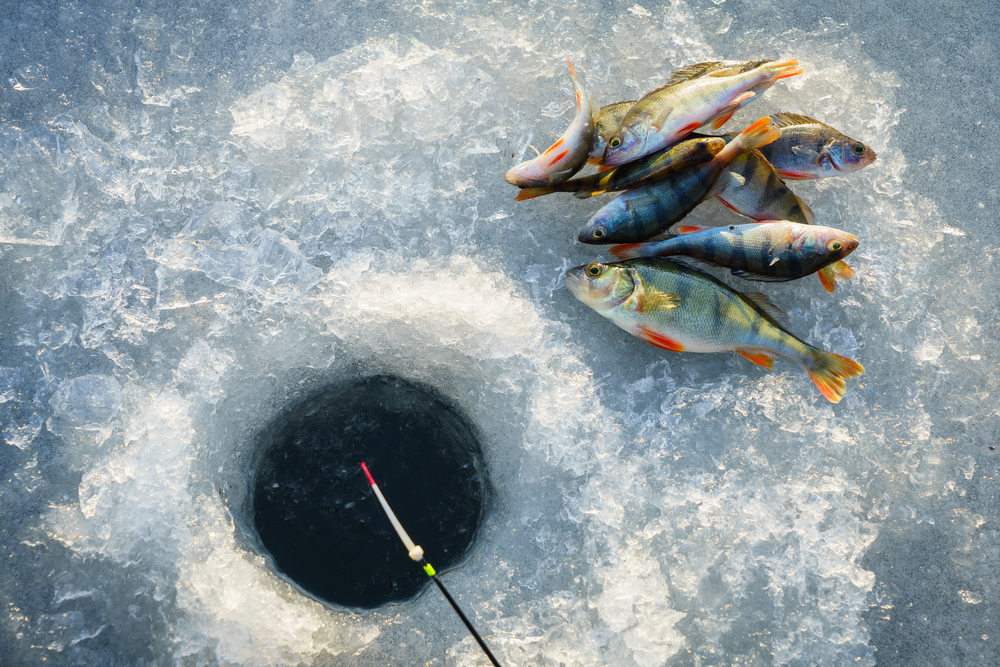The concept sounds crazy to some. For others, there’s no better way to get outdoors in the winter.

Walleye, perch, sturgeon, lake trout: These are among the cold-water species prized by ice fishing aficionados. Many insist that winter is the easiest time of year to catch fish; the uninitiated are often surprised to find they bite like crazy in subzero weather. The fishing may be “easy,” but getting your line in the water is not. You have to drill a hole in rock-hard ice—and you have to brave the weather. Here’s what you need to know to get prepared and stay safe.
The Gear
The most important piece of equipment is a giant drill called an auger—this is how you access the ice under the water. These are typically six inches in diameter or larger; they’re expensive, but you can try to rent one if you’re not ready to take the plunge.
You won’t be using a typical rod. Instead, there are two main approaches: a short ice-fishing rod (these are incredibly basic compared to the standard rod—you can get by with tying your line to a 30-inch broom handle), plus multiple “tip-ups,” which are small frames that straddle the hole and are outfitted with a flag that swivels up when you have a bite (how many of tip-ups each person can use depends on local regulations).
Otherwise, most of your gear (except safety gear, clothing and an optional ice shanty—see below for these) will be identical to any other fishing trip: bait/lures, tackle box, stool, bucket, cooler, fillet knife, and so on. You will also need a seasonal permit.
The Methods
During the summer, it is common to fish the shallows, but in winter, fish often congregate in deeper water. Typically, one drills numerous holes over a large area (but within eyesight of each other) that are worked simultaneously. At the main hole where you keep your supplies, jig with your rod, trying out various depths. At the other holes, set up your tip-ups. These are typically aimed at big fish who trawl along the bottom; setting the bait about one foot above the lake bed is recommended. When you see a flag pop up, run over and pull up the line. Any cold-water fish inhabiting a given lake in summer should also be there in winter.
Staying Warm
Obviously, you need to layer like crazy. Assume there will be wind; add an extra wind-proof layer over what you would normally wear to stay outdoors for hours on end at whatever temperature is forecast. Insulated boots are a must, as are two pairs of gloves: heavy mitts for when you’re sitting around, plus a pair of “liner” gloves underneath for when you need to do stuff with your fingers. Snow goggles are highly recommended.
To make it easier, many folks use ice fishing shanties that they tow out onto the lake and leave all winter long. These can be outfitted with heaters and cooking stoves; some people are known to bring generators and set up a TV. In regions where ice fishing is popular, you can rent a shanty by the hour.
Safety
Drowning in freezing water is no way to go. If you don’t know what you’re doing, the first rule is to go with someone who does (and never go by yourself). While ice as thin as two inches can support a human, the ice on frozen lakes is never a uniform thickness—it might be three inches in one area while only one inch thick in another.
If there is any question as to thickness, drill a hole near the edge with a cordless drill and measure it: Be safe and don’t venture out unless it’s at least four inches thick where you drill. Most folks bring a metal rod to tap the ice in front of them as they walk; a hollow sound is a bad sign, while a sharp rapping noise usually means that the ice is firm. Always bring a flotation device and a rope in the event that someone falls through.
Where to Go
If you live in the right climate, go where the locals go. (Hint: Ask around at tackle shops.) Otherwise, you’ll have to travel. In some cold-climate locales, especially scenic ones, you’ll find a minor industry devoted to ice fishing tourism. Places such as Banff, Alaska, and Scandinavia have no shortage of professional ice fishing guides that will take you on the trip of a lifetime—food, shanty, and gear included. Peruse fishingbooker.com for chartered trips. Iceshanty.com is the Internet’s main hub for ice fishing information, sharing advice, and connecting with fellow enthusiasts.
M